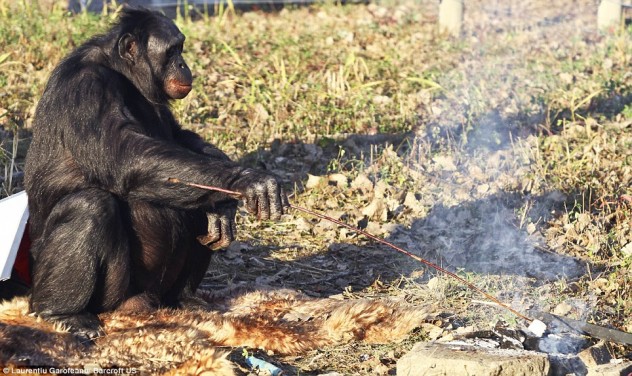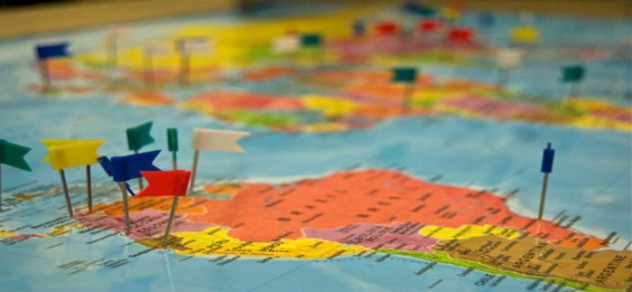 Mysteries
Mysteries  Mysteries
Mysteries  History
History 10 Surprising Stories About the Texas Rangers
 Humans
Humans 10 Philosophers Who Were Driven Mad by Their Own Theories
 Miscellaneous
Miscellaneous 10 Video-Game-Worthy Weapons and Armors from History
 Weird Stuff
Weird Stuff 10 Psychics Who Accurately Predicted Wartime Events
 The Arts
The Arts 10 Pieces of Art Inspired by a Broken Heart
 Health
Health 10 Science Fiction-Sounding New Medical Treatments
 History
History 10 Surprising Facts About the Father of Submarine Warfare
 Space
Space Ten Astonishing New Insights into Alien Worlds
 Weird Stuff
Weird Stuff 10 Bizarre Summer Solstice Rituals Still Practiced Today
 Mysteries
Mysteries Top 10 Haunting Facts About the Ghost Ship MV Alta
 History
History 10 Surprising Stories About the Texas Rangers
 Humans
Humans 10 Philosophers Who Were Driven Mad by Their Own Theories
Who's Behind Listverse?

Jamie Frater
Head Editor
Jamie founded Listverse due to an insatiable desire to share fascinating, obscure, and bizarre facts. He has been a guest speaker on numerous national radio and television stations and is a five time published author.
More About Us Miscellaneous
Miscellaneous 10 Video-Game-Worthy Weapons and Armors from History
 Weird Stuff
Weird Stuff 10 Psychics Who Accurately Predicted Wartime Events
 The Arts
The Arts 10 Pieces of Art Inspired by a Broken Heart
 Health
Health 10 Science Fiction-Sounding New Medical Treatments
 History
History 10 Surprising Facts About the Father of Submarine Warfare
 Space
Space Ten Astonishing New Insights into Alien Worlds
 Weird Stuff
Weird Stuff 10 Bizarre Summer Solstice Rituals Still Practiced Today
10 Amazing Human Behaviors In Apes And Monkeys
Being our closest living relatives, it’s not surprising that we have a thing or two in common with apes and monkeys. Obviously, when it comes to our bodies, we’re extremely similar but also clearly distinct. While we might still be a quite a bit away from a Planet of the Apes–type world, the examples below show that it might not be that crazy an idea after all.
10 Cooking

Kanzi is a 31-year-old bonobo living in the Great Ape Trust in Des Moines, Iowa. And he can do a lot more than use tools to catch food: He can use them to cook food. Kanzi likes to roast marshmallows as well as make hamburgers in a frying pan. Of course, he doesn’t make his own frying pan, grill, and spatula. He just knows how to use them.
But he does make his own fire. Kanzi will go around his enclosure and collect wood before striking a match and cooking away. That’s right—he uses matches. Scientists at his home taught Kanzi how to use them, saying he wanted to learn after watching a film about cavemen discovering fire. They say he is surprisingly good at it, too, picking it up quickly and taking care not to burn himself. He stands well back from the campfire, keeping it alight by throwing wood on it.
9 Using Money

Thanks to some scientists in Connecticut, seven monkeys have learned to understand the basic concept of money. They spent a few months teaching the monkeys that they could exchange tokens for grapes, apples, or Jell-O. Eventually, the monkeys caught on and were given 12 tokens to spend as they pleased.
But this isn’t just a case of the monkeys carrying out some action knowing they’ll be rewarded with food. Once the scientists were able to establish which products were more in demand, they introduced fluctuations in their price, and the monkeys changed their spending habits. Originally, a monkey could, for example, buy a bunch of grapes or a cube of Jell-O for one token. Later on, they could use one token to get a bunch of grapes, or two cubes of Jell-O. Once the monkeys realized this, they were more likely to spend more of their money on Jell-O. The monkeys knew they had a limited amount of money and had to spend it wisely. The researchers noticed that most of the time, the monkeys would buy the cheaper food, thereby giving them more purchasing power.
8 Prostitution

When they began the experiment, the researchers at Yale–New Haven Hospital probably never thought the monkeys would spend the money on something that wasn’t even on the menu. Right after they learned to steal, one of the monkeys took one of the stolen coins and gave it to another in exchange for sex. The prostitute monkey then used the token it was paid to buy a grape. Although it was unplanned, this helped show that the monkeys really did understand that the tokens had value. Despite helping their research, measures were taken to prevent this sort of behavior occurring again.
7 Gambling

This Connecticut experiment is beginning to sound a lot less like science and a lot more like Vegas. This time, the scientists decided not to use the tokens and just stick with grapes. They played two nearly identical games with one key difference—one was made to look positive, and the other negative.
In the first game, a monkey would approach the table and be given a grape. A coin was flipped, and if the monkey won, he’d get another grape. If he lost, he’d still get to keep the first grape. In the second game, each monkey started with two grapes. If he won, he’d keep both; if he lost, he’d only keep one. So the odds were exactly the same: If they win, the monkeys get two; if they lose, they get one. Despite the outcomes being the same, researchers found that the monkeys preferred to play the game where they won a grape instead of lost one.
In another experiment involving rhesus monkeys, researchers presented the monkeys with two lights. Looking at one guaranteed the monkey a certain amount of juice. Looking at the other was a gamble, and the monkey could end up with either more or less juice than the other light gave. Even after the experiment was manipulated so that the gambling light gave out less juice overall, they found that the monkeys preferred to gamble. They reasoned that the excitement of winning made up for the actual loss in juice. The monkeys got a thrill out of taking a risk, which researchers hope will help to provide insight into how the brains of gambling addicts work.
6 Head Shaking

Bonobos are great apes, as are chimps, gorillas, orangutans, and humans. Because they share over 98 percent of our DNA, many scientists consider bonobos to be the closest living relatives of mankind. Our similarities extend beyond appearances, and bonobos are known to use a wide range of body language and vocals to communicate. One of the most interesting examples is that bonobos sometimes shake their heads at each other to illustrate disapproval.
Darwin believed that we adopted this behavior as infants. Infants who were accepting breastfeeding would lift their heads up, and those who did not want to be fed would shake their heads. This behavior stuck with us to adulthood and is why we associate nodding with a positive reaction and head shaking with a negative one. Though doubted by some, this theory could explain why bonobos seemingly use it in the same way.
5 Using Tools

One of the biggest turning points for human evolution was the use of tools. In recent years, similar thought processes have been observed in monkeys. Many have been seen using tools for a wide variety of things, even in the wild. For example, the capuchin monkey has gained a lot of attention from scientists recently after being seen using rocks to dig holes and crack nuts.
Meanwhile, chimpanzees have been observed snapping off branches, stripping them, and shoving them into holes to fish out termites. They even use different sticks for different tasks. When fishing for ants, chimps will use a longer, stronger stick and stay further away to avoid being bitten. This is significant because it shows that they understand certain tools are better suited for certain tasks. It’s also important to note that they usually select branches from bushes or trees instead of just finding ones that will suit on the ground. This basic skill shows means-end rationality.
4 Cultural Transmission

Cultural transmission, or cultural learning, is how a society spreads new information. For years, it was thought that humans were the only animals with culture, but we know now that this isn’t the case. Learned behavior can be passed on from one animal to the rest of their group and completely change the way that group functions. No story illustrates this better than that of Imo.
Imo was a macaque in the ’50s who became famous among psychologists worldwide for the innovations and influence she brought to her troop. She and her troop lived on a tiny island called Koshima in Japan, where they were fed grains and sweet potatoes by researchers. Despite the fact that macaques tend to steer clear of water, Imo took the potatoes she was being fed down to the sea and washed the sand off them. Not only did this mean the potatoes were cleaner, the saltwater made them taste better. After a while, pretty much everyone in her troop began to wash their potatoes before eating them.
As time went on, the monkeys began going deeper and deeper into the water, becoming less afraid and even starting to play and swim in it. Imo came up with another revolutionary idea some time later: She would take the grains they were fed and throw them in the water. The grains would float, and the sand would sink, making it far easier to separate the grains from the sand.
3 Sign Language

Apes are the first animals that can communicate relatively complex messages with each other, and more importantly, with us. While there are a number of apes that have been taught to sign, the best example is the ongoing Project Koko. Koko, a gorilla, began to learn sign language when she was a year old, and has since learned to communicate about 1,000 signs, as well as understand about 2,000 English words.
She can understand spoken English and responds through signing. Some researchers are skeptical of Koko’s abilities, claiming she doesn’t understand language, but only signs in order to be rewarded. However, the researchers behind the project strongly disagree, saying that Koko asked for a kitten for Christmas one year. At first she was given a toy cat, but she hated it. So eventually she was allowed to pick out a real cat to keep as a pet. When the cat was hit and killed by a car, Koko used her sign-language abilities to convey how upset she was.
2 Use Computers

Apps for Apes is an Orangutan Outreach program that uses iPads to help keep orangutans stimulated. Orangutans are extremely intelligent, and these iPads are used as a type of “mental enrichment” to prevent the apes from becoming bored or depressed. When the iPad was unveiled in 2010, Richard Zimmerman was thinking that they were ideal for orangutans to play with. So far, the apes love them, generally sticking to children’s games but also watching some nature documentaries. (The zookeepers have to hold the iPads for them because they can get frustrated and smash the screens.) You can see a video of orangutans using an iPad here.
Some macaques were trained to play a game where they had to guess the density of an object on screen as either “sparse” or “dense.” A correct guess resulted in a treat, but an incorrect one meant the monkeys had to wait a few moments for the next question, and macaques hate waiting. They also had the option of passing, which meant no waiting penalty would be imposed. Researchers found that the monkeys doubted themselves in the same way we do: They answered questions they felt confident about but skipped the more ambiguous ones. This may not seem like a big deal, but for researchers it was. These findings suggest that they have high levels of self-awareness.
1 Fishing

Fishing is a completely different level of skill altogether, but that hasn’t deterred monkeys. After seeing humans fishing with spears, an orangutan in Borneo decided to try for himself. Although he wasn’t able to spear any free-swimming fish, he has learned to use his spears to catch fish caught in the nets of the fishermen he was copying.
Not to be outdone by their great ape cousins, macaques have more successful fishing ventures. Although they hunt without tools, some of these monkeys in Indonesia have been spotted catching fish with their bare hands since 1998.








